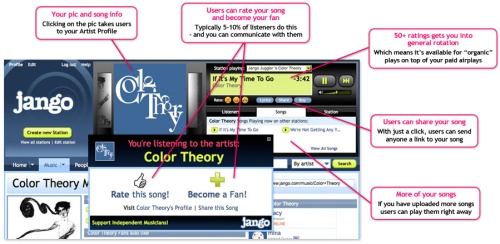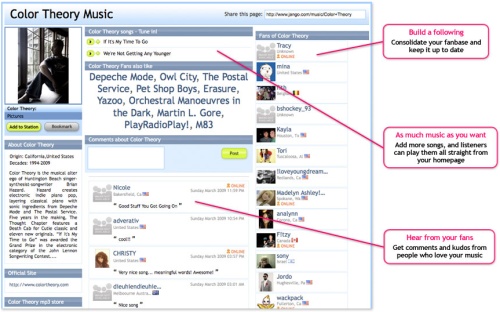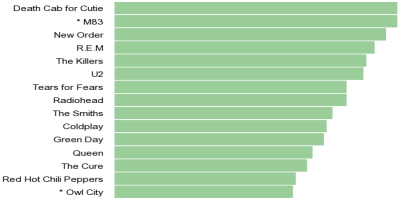
Would you pay $1 for a new fan? Would you pay 2 cents to have your song played to a fan of your favorite band? I would, and did, with Jango Airplay. Jango offers free internet radio that plays listener-selected artists alongside similar artists. Tell it which artists and songs you like and dislike, and it adjusts accordingly. Basic social networking features are included, allowing listeners to share music and compare tastes. Jango Airplay lets artists buy their way into Jango’s recommendation engine, promising guaranteed airplay alongside your pick of popular artists. You can buy 1000 plays for $30, 2000 plays for $50, or 5000 plays for $100. I started with 5000 plays, and was so encouraged by the results that I spent another $200 for 10,000 more.

When your song is played, a pop-up appears on the listener’s screen. They can close it, ignore it, “like” the song (give it a thumbs up), or become a fan. Once the song gets 50 likes, it enters general rotation, generating non-paid plays that continue after the paid campaign ends. The “how it works” page (featuring yours truly as official poster boy) says that typically 5-10% of listeners will rate the song or become a fan. My results were even better, with 12% of paid plays resulting in likes. It only takes 5% to put the song into general rotation after 1000 plays, which can be had for $30. That said, just reaching general rotation doesn’t mean the song will be played very often. The more likes it has, the more it will come up. I’m currently averaging about 25 free plays per day, approaching the halfway point of my $300 promotion. About 2% of listeners became fans of my music. At 2 cents per play, that’s $1 per fan. I’m obviously using the term “fan” loosely here, since liking one song hardly constitutes any sort of personal commitment. Some listeners may have heard the song multiple times before becoming a fan, which would give their declaration a tad more significance.

A couple of days ago I messaged each of my fans to introduce myself, invite them to visit my web site, and let them know where to buy my albums. So far I’ve received four messages back and one order by e-mail, though only about 20% of the messages have been opened. Yesterday Jango added a bulletin feature which lets artists communicate with all their fans once per week. Unlike messages, bulletins are visible from the listener’s home page, so I expect a better response rate. $300 is nothing to sneeze at, especially when stacked up against sales of my music. What exactly is my return on that investment?
- Increased sales. I can only verify $20 in direct sales, but it’s reasonable to expect a few iTunes sales as well. My Amazon physical CD sales are way up this month, but that could be a coincidence.
- Royalties. Jango promises to pay royalties on every play, though who knows what that will amount to. In January, the US Copyright Royalty Board announced that it will apply royalties to streaming net services based on revenue. For argument’s sake, if it’s a half cent per play, I’ll eventually get $75 back from SoundExchange.
- Song feedback. Listeners are encouraged to comment on the songs. There are over 100 comments on my profile already, though it’s not always clear which song is being commenting on.
- Improved targeting. Jango tecently added the Fan Overlap Report, which provides some insight into the musical tastes of the listeners who like your song. The asterisks indicate artists I’ve already selected as similars.

Analyzing current sales and royalties from the paid plays is a bit shortsighted. My guess is that within five years, everyone will be able to listen to anything, anywhere, for a small monthly fee. Artists will receive royalties based on their proportional share of plays. If that scenario comes to pass, investing in new fans could pay dividends for a long time to come.
EDIT: A Jango representative read this article and gave me an affiliate code. If you are considering trying Jango Airplay, please use this link! Any money earned will be used to buy more plays for my songs. I will continue to report back with my results over time.
UPDATE 10/19/09: I promised to report back with my results, so here they are. It’s been six months since I wrote this article. I’ve “recycled” the few hundred dollars I made in affiliate earnings back into my campaign, but invested no more money of my own. My current stats are:
37076 plays (29582 paid), 3528 likes, 413 fans, 1837 views
I’m only averaging 25 unpaid plays a day, where I used to get double that. I get more on my totally neglected MySpace page! Maybe there are a lot more artists in the system now, or maybe listeners aren’t listening to similar bands as much, or maybe Jango doesn’t have as many listeners as it used to.
I still have no reliable way to quantify my return, but Jango continues to bring in occasional sales, mailing list sign-ups, Facebook requests, and Twitter followers. While I stopped keeping track after the first $100 or so, my totally unscientific guess is that I’ve earned back maybe half of what I’ve spent. At least a dozen Jango listeners have converted into “real” fans, who I regularly interact with. Maybe the exposure will pay off in the long run, maybe not. Still, if I had a dedicated promotion budget, I’m not sure where else I would spend it! Between a traditional radio campaign and Jango, there’s no contest.
Brian Hazard is a recording artist with fifteen years of experience promoting his seven Color Theory albums. His Passive Promotion blog emphasizes “set it and forget it” methods of music promotion. Brian is also the head mastering engineer and owner of Resonance Mastering in Huntington Beach, California.